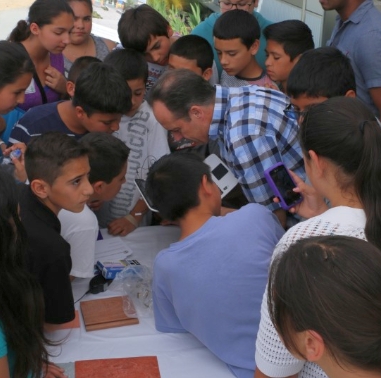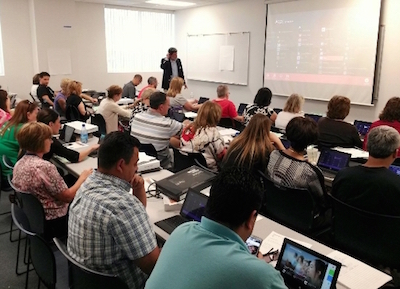Mobile Initiatives
California District Deploys 23,000 1-to-1 Devices, Works To Quell Parental Concerns
- By Dian Schaffhauser
- 02/03/15

Manteca superintendent shows students the new devices
Manteca Unified School District in California is in the next phase of its $30 million project to outfit its 23,000 students with computers. In response to earlier parental concerns regarding the program, the district posted information on its site addressing the most common questions and held two seminars specifically to educate families about software usage.
Besides the new devices, the "Going Digital" project has involved implementation of new fiber optic cable and deployment of wireless access points in classrooms. Teachers have been equipped with Microsoft Surface Pro 2 computers and been given training on the devices and the use of digital curriculum.
In mid-January the district took delivery of 23,500 3E devices, a Panasonic 2-in-1 device that features a detachable or reversible touch tablet and keyboard/docking station that fit together to form a portable computer. The unit is outfitted with Windows 8.1 Pro for Education, an Intel Atom 1.3GHz quad core processor, a 10-inch 1,366 x 768 display, 2 GB of memory, 32 or 64 GB of storage, USB and HDMI ports, microphones, camera, stylus slot, and Bluetooth. The device also includes a couple of unique accessories: a temperature probe and companion app and a magnifying lens that magnifies images seen through the built-in camera. Students in grades 4-12 will be allowed to take the computers home; K-3 devices will remain in carts in the classroom.
The goals of the program, as laid out in a January 2014 presentation to the school board, include providing students "with an equal opportunity to technology at all school sites." It undertook the initiative with very little in place. In a scope document, the district said that each school previously had a minimum of one computer lab with 36 computers and a network infrastructure "using antiquated technology that will not support the wireless and wired network equipment needed to accomplish the goals"; most of it had "reached or is reaching the manufacture[rs'] end of life/support cycle."
The network upgrade, anticipated to sustain the district for at least seven years, included setup of new Cisco Nexus 9000 switches and Cisco 802.11ac wireless access points for classes. Core and edge network upgrades were expected to support 10 Gbps speeds between sites and 1 Gbps within each site.
Equipment upgrades, wiring and cabling have consumed about $22 million of the total budget. The devices and were budgeted to cost $8 million. The district has budgeted for a four-year refresh cycle on the student devices. The funding came from a one-time state allocation.

Manteca teachers receive training
"One-to-one initiatives give students a leg up, increasing engagement and nurturing digital literacy. Moreover, we have invested in 3E devices which are specifically designed to promote inquiry-based learning and excellence in STEM subjects," said Superintendent Jason Messer in a statement. "Our vision is to ensure that all students in our district will have access to world-class learning and will graduate with skills that allow them to compete with students from anywhere else in the country."
According to coverage in the Manteca Bulletin, a group of parents had launched a campaign "to get their voices heard and to get answers from school officials." Ironically, they're choosing a high tech means to publicize their efforts: a closed page on Facebook. As the Facebook page stated, "Our goal is to come together as a group, make our concerns heard to the district and together try coming up with a resolution that we can agree on. We want to make clear that we're not completely against the technology part of this program; however everything else is what we're having the majority of our issues with." So far the closed group has 72 members.
Among their concerns: The district hasn't fully answered questions about the digital program; families are being "forced" to sign a contract and pay insurance related to student possession of the devices; and students who don't use the devices at home could lose out on "homework points," thereby affecting their grades.
At about the same time as the Facebook campaign started, the district scheduled two 90-minute parent sessions to help them learn about the use of Microsoft Office 365, the software chosen for the devices.
A 10-page frequently-asked questions document was also posted to the district site. Among the major concerns addressed:
- Whether the child has to bring the device home at night. (The answer is yes; "The devices are an educational requirement.... Please note this is just like a textbook, the devices are a key supplemental part of the educational program....")
- What families have to pay for the use of the tablet. (Nothing; however, the district does offer a lease/purchase program.)
- Whether the "Going Digital" steering committee can be expanded to include parent members. (The committee already has parents and students, but it will be expanded to include additional members.)
About the Author
Dian Schaffhauser is a former senior contributing editor for 1105 Media's education publications THE Journal, Campus Technology and Spaces4Learning.